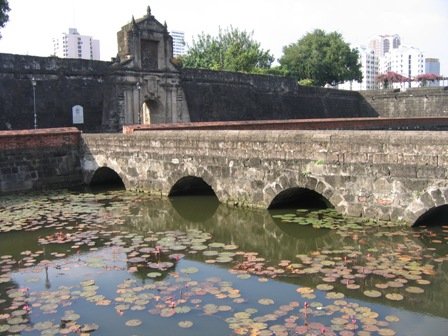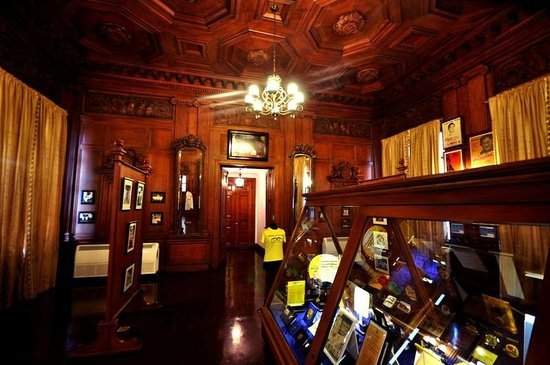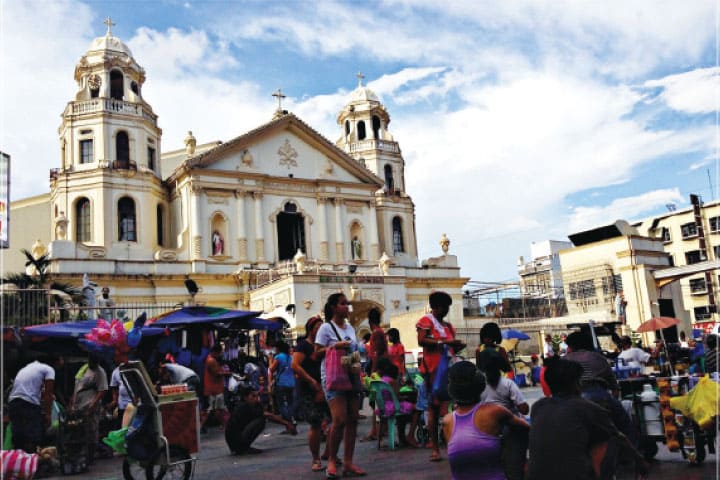Manila Attractions – Image courtesy of manilahums.weebly.com
Top 10 tourist attractions in Manila, Philippines.
Manila, the chaotic, congested capital of the Philippines, and also known as the “Pearl of the Orient,” is usually just a stop-over for tourists planning to see the exotic, scenic provinces of the Philippines. However, you must not underestimate Manila and its many charms.
Manila, the center of education, business, and transportation, may have a reputation as a crowded, polluted, traffic-crazy, and poverty stricken city. But beyond the still-harmless haze of pollution, the sporadic traffic, the shantylands, Manila has a lot of hidden gems—and you’d definitely feel sorry if you miss them in your trip to the Philippines.
Manila is developing quite rapidly and offers a lot of rewarding experiences. From stunning architecture dating back to the Spanish colonial period, megamalls, museums, art galleries, and amusement parks, it’s definitely easy to have fun in Manila.
There are many things to love about this city, plenty of things to see and do, and here are just 10 of the best Manila attractions.
1. RIZAL PARK
Located along Roxas Boulevard, by the Manila Bay, Rizal Park is also known as Luneta. This is a major tourist spot in Manila and definitely a favorite leisure area for Filipinos.
Rizal Park was named after the Philippine national hero, Dr. Jose Rizal whose remains are enshrined in the park with his bronze-and-granite 100-year-old monument an imposing sight, constantly reminding the Filipinos of Rizal’s fight against the Spanish colonization.
Just 100 meters from his monument is the exact location where Rizal was executed, re-enacted by statues.
The 58-hectare urban park is one of the largest in Asia, perfect for picnics or simply removing yourself from the city’s noise and pollution.
The park features a musical dancing fountain, a giant raised-relief Philippine map in an artificial lake, and artworks from famous Filipino artists.
Also, check out the marble marker Kilometer Zero in Luneta—the point of origin for gauging the distance to every province and city in the country.
2. INTRAMUROS
Also known as the “Walled City,” Intramuros is the oldest district in Manila. Built in the late 16th century by the Spanish colonial government, Intramuros (Spanish for “within the walls”) protected the city from foreign attacks. It’s a series of stone walls and forts enclosing a pentagon-shaped area 0.67 sq km in size, with a fascinating collection of courtyard houses, stone palaces, monasteries, convents, and schools.
In 1951, Intramuros underwent reconstruction due to the damages caused by WWII, specifically during the battle to recapture Manila from the Japanese Imperial Army.
At Intramuros, you can enjoy a very old-fashioned calesa ride, a horse-drawn carriage first used in the 18th century. Also, you can visit the Intramuros museum, Fort Santiago, and check out other historically significant plazas, monuments, churches, and public buildings.
Casa Manila in Intramuros is also a must-visit—the house is a recreation of a typical upper-class colonial home in Intramuros. Delight in the antique furniture inside, artifacts from the Spanish era, artworks, and basically imagine a wealthy existence during that period. An entrance fee is required in Casa Manila: Php75 for adults; Php50 for children. It is open from 9am to 6pm.
You can also enjoy an afternoon of golf at the Club Intramuros Golf Course, and shop for souvenirs and local art in stores and galleries making these options one of the more popular Manila attractions.
3. FORT SANTIAGO
Image courtesy of www.philippines-travel-guide.com
One of the most important historical sites in Manila, Fort Santiago is a citadel, as well as Intramuros’ main tourist attraction. Located at the mouth of the Pasig river, Fort Santiago used to be the site of Muslim-Filipino leader Rajah Sulayman’s settlement before the Spanish rule. During the Spanish occupation, many lives were lost in its prisons.
Visiting this rich historical site will reward you with plazas, manicured gardens, fountains, a lily pond, and, of course, the Rizal Shrine museum, where Jose Rizal, the great Filipino hero, was imprisoned in 1896 as he awaited his execution.
There’s also the Baluarte de Santa Barbara, a restored 18th century Spanish military barracks, known as the site where hundreds of Filipino and American POWs were killed.
You will also get to see various dungeon cellblocks—one of which was Rizal’s on his last night alive. You will see marks of brass footprints to trace the hero’s final steps to his execution spot in Luneta.
4. SAN SEBASTIAN CHURCH
Manila Attractions Image courtesy of en.wikipedia.org
Check out the only all-steel basilica in the Philippines—and the only prefabricated steel church in the world.
Designated as a National Historical Landmark by the Philippine government in 1973, San Sebastian Church was completed in 1891, a product of the collaboration of seven countries: Belgium, Britain, Germany, China, France, Spain, and the Philippines.
Located in Quiapo, Manila, San Sebastian Church is noted for its Gothic Revival architecture. Although made entirely of steel, the church’s interior was designed by the students of Academia de Pintura, Dibujo y Grabado to look like it was crafted from stone.
The “Eiffel in Quiapo” is an absolute must-visit for its grandeur and amazing architecture—truly a national cultural treasure.
5. MANILA OCEAN PARK
Image courtesy of www.tripadvisor.com.ph
Owned by China Oceanis Philippines Inc., Manila Ocean Park, located just behind Luneta, is 8,000-sq ft oceanarium –larger than Singapore’s Sentosa Underwater World.
Manila Ocean Park has plenty of attractions; There’s the Agos, a collection of 8 tanks of freshwater fishes in a rainforest theme; Bahura, a display of artificial corals; Kalaliman, which gives you an amazing opportunity to see marine animals found in the deepest parts of Philippine waters; Pagi, an overhang tank filled with a variety of rays; Pating, where you can witness sharks; and Buhay na Karagatan, Manila Ocean Park’s chief attraction—a 25-meter long walkway tunnel with a 220-degree curved walls.
Manila Ocean Park also features the tallest musical fountain in the Philippines—120 feet high. It’s also the country’s largest water and laser show. Catch sea lions perform, a penguin talk show, snorkelling, diving, enjoy a Philippine and Asian cuisine, stroll through the marine-themed mall and other park attractions and mini adventures.
6. COCONUT PALACE
Image courtesy of en.wikipedia.org
Located on the campus of the Cultural Center of the Philippines, the Coconut Palace is the official residence of the Vice President of the Philippines, as well as his main workplace.
The Coconut Palace is also known as Tahanang Pilipino, and 37 million Philippine pesos was spent to build it. The palace is too opulent that Pope John Paul II even refused former First Lady Imelda Marcos’ invitation that he stay at the palace during the Papal visit in 1981.
The octagon-shaped Coconut Palace is made of various hardwood, coconut shells, and a specially engineered coconut lumber. Inside, marvel at the 101 coconut-shell chandelier and the dining table made of 40,000 tiny pieces of inlaid coconut shells.
The Coconut Palace has been a guesthouse for public figures and celebrities, like George Hamilton, Brooke Shields, and al-Gaddafi, and has been featured in several TV shows, like the “Amazing Race.”
The Coconut Palace is open for tours from Tuesdays to Thursdays at 9 a.m., 10:30 a.m., and 2 p.m. Tour schedules, however, may change without prior notice
7. NATIONAL MUSEUM OF THE PHILIPPINES
Located on Taft Avenue, Ermita, the National Museum of the Philippines features collections of the ethnographic, anthropological, archaeological and visual artistry of the Philippines. And it is also home to Juan Luna’s famous masterpiece, the Spolarium.
In the museum are amazing collections of Philippine treasures, which include the Manunggul jar, one of the most precious jar collections in the country,. The jar dates back to 890-710 BC and was excavated from a Neolithic burial site in Manunggul Cave, Palawan.
The museum also has a gallery called “The Origin,” featuring the four periods of Philippine pre-history: Paleolithic, Neolithic, Metal, and Ceramic Age. In the museum, you can also check out the anchor of the Galleon San Diego, a Spanish battleship that sank in 1600 just off Manila Bay. Other highlights in the museum also include a prehistoric boat, the Butuan boat, dating back to 1250 AD.
Stunning artworks by Philippine national artists, cultural treasures, and paintings depicting Rizal are just a few of the many fascinating collections in the museum, which will give you a deeper insight into the country’s rich and colorful history.
The National Museum is open Tuesdays to Sundays, from 10:00 AM to 5:00 PM. Entrance fee is 150 pesos for adults; students 50 pesos. Free admission on Sundays, it is one of the most popular Manila attractions for tourists.
9. BINONDO, CHINATOWN
Established in 1584 by the Spaniards as a settlement for Chinese immigrants, Binondo is the oldest Chinatown in the world. But even before the Spanish rule, it was already the center of Chinese commerce. Today, Binondo remains to be one of the largest and most authentic Chinatowns in the world.
The vibrant Chinatown is still thriving, crammed with wholesale stores, exotic cuisines, and high quality Chinese restaurants.
There’s also the Binondo Church in the area, which also attracts foreign tourists. During festivals, Binondo comes even more alive with parades and fanfare.
Just last year, in June 2015, a new Chinatown arch was inaugurated to celebrate both the 144th founding of the city of Manila and the 40th year of diplomatic ties between the Philippines and China. The brand new Chinatown arch is now considered as the largest Chinatown arch in the world—3.8 feet taller than the one in Washington, DC.
Within Chinatown, the must-see spots are Ongpin Street, Plaza Calderon dela Barca, traditional Chinatown shops and restaurants, Carvajal Alley Market, and Basilica de San Lorenzo Ruiz.
9. MALACANANG PALACE | PRESIDENTIAL MUSEUM AND LIBRARY
Image courtesy of www.tripadvisor.com.ph
Malacanang Palace is the official residence and the chief workplace of the President of the Philippines. Originally built and structured as a summer house in 1750 for a Spanish aristocrat, it only became the official residence of the chief executive in 1863 and remains one of the most popular Manila attractions for the visiting backpacker and tourist.
Malacanang, with its fascinating architecture style of Spanish colonial and Neo-classical, welcomes visitors to the Presidential Museum and Library.
Experience a full immersion into Philippine history by visiting the Presidential Museum and Library’s collection of artifacts from the first president, Emilio Aguinaldo in 1896, up to the present. Marvel at the intriguing memorabilia relating to the 15 presidents of the Republic of the Philippines, and visit Quezon’s office, the First Lady’s room, and be fascinated by the building itself: high ceilings, ornate wood panelling, capiz windows, glittering chandeliers, and polished floorboards.
The Presidential Museum and Library has a total of nine sections, which includes the Pulpit, where iconic laws are displayed such as Ferdinand Marcos’s copy of the Proclamation No. 1081 or the Martial Law.
The tour is an hour long but very rich in information that are definitely not found in published materials. Before the tour, you will be briefed with the house rules. Camera is allowed—but just one, even if you’re traveling with a group.
The Presidential Museum and Library is open from Mondays to Fridays: 9 am to 12 pm; 1 pm to 3 pm (except on public holidays). The entrance fee is P50 for adults; P30 for students and senior citizens. You must follow the dress code: smart casual (shorts, sleeveless tops, and slippers are not allowed).
However, you cannot simply show up. Online reservation is required 10 days ahead of your scheduled tour and it is highly important that you follow THESE RULES when planning a tour to Malacanang to see this most famous of Manilla attractions.
10. QUIAPO
Image courtesy of www.mb.com.ph
The Manila district of Quiapo is rather fascinating. Busy, chaotic, congested, and vibrant.
There are plenty of tourist spots to check out in Quiapo: firstly, the Quiapo Church, along Quezon Boulevard, with its famous Black Nazarene—the black statue of what the Catholics portray as Jesus.
There’s also Plaza Miranda, a remarkable place selling a variety of superstitious objects, like amulets.
There’s also the Golden Dome Mosque, which was built in 1970s, for Muslims (a large part of Quaipo is a community of Muslims). There’s also the Ocampo Pagoda, a mix of European and Oriental architecture.
There are plenty of historical houses in Quiapo as well, like the Boix House, the former boarding house of former President Manuel Quezon and other notable figures. It was built in 1895 of Neo-Renaissance ornamentation.
There’s also the Bahay Nakpil-Bautista, Paterno Mansion, Zamora Mansion, Padilla Mansion, and Don Jose Sulpicios Orpilla Mansion.
It is advisable that you get a local guide to tour you, as you can easily get lost in Quiapo. Also, having a tour guide would provide you with a more educational experience around this most famous of Manila attractions.
Helpful articles and blog posts on Manila attractions!
We only recommend writers and blogs that we read regularly and believe will deliver substantial value to our readers. The following is our top picks of articles we think are worth reading for reviews on some of the tourist attractions that we mentioned.
- Luneta Park and Intramuros, Manila – by Travel Adventure
- The Beauty of Quiapo – by Lakwatsero
- The First-Timer’s SAFE Travel Guide to Manila, the Philippines (from a local) – by Will Fly for Food
- Inside the Malacanang Palace – by Batang Lakwatsero
- Manila Ocean Park, a fun way to spend an afternoon – by Asia Travelbug
Do you have an awesome link to a relevant well written article that should be included here? If so, hit us up on Twitter by following and messaging us the link.
How Did We Do?
Is the article ” Manila attractions – 10 essential places to see in Manila” useful? If so, please share and like this post, as it helps other travelers find information. Many thanks! You can follow us on Twitter or Facebook for further updates!







